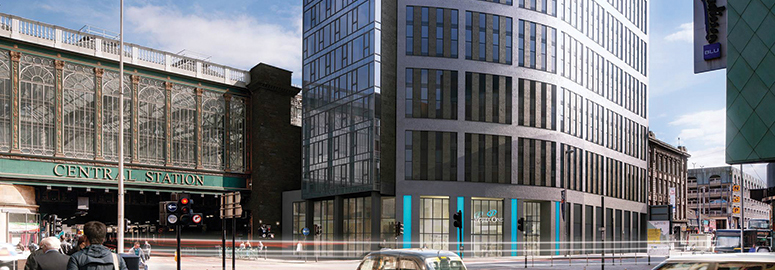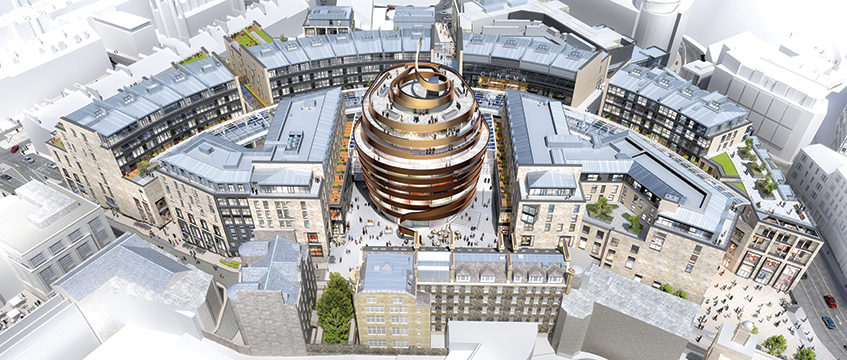Edinburgh is the UK’s second most visited tourist destination, and hospitality is helping drive the Scottish capital’s key regeneration projects. At TH Real Estates’s £1bn mixed-use Edinburgh St James development, a five-star W Hotel will occupy a striking 12-storey structure that will tower over 850,000 sq ft of new retail and leisure space. Claire Robson reports
Starwood Hotels & Resorts is opening the 214-bed landmark ribbon hotel, along with an additional 39 rooms in the adjoining James Craig Walk building.
“The hotel is the centrepiece of the project”, says TH Real Estate’s director of development, Martin Perry. “W Hotel is a very contemporary young brand which will attract a different type of clientele to the city.”
According to the developer, between 2010 and 2015 Edinburgh’s five-star hotel market enjoyed a 50% rise in revenue per average room (RevPAR).
TH Real Estate attracted significant interest from hotel operators wanting to locate at the site and is in negotiations with a four-star aparthotel to bring an additional 70-plus rooms to the scheme.
“W Hotel will be a great addition to the city”, says Savills director Keith McBrain. “The brand will bring with it a whole new group of customers and bolster a strong five-star market which still has scope for growth.”
He adds: “There has always been a four-figure pipeline of new rooms in Edinburgh, but demand is such that the city can easily absorb new supply.”
According to JLL, there are around 12,000 hotel rooms in Edinburgh, with an additional 1,500 due to be delivered by 2018, as operators look to exploit strong visitor demand.
STR Global figures indicate that during 2016 hotels in Edinburgh reported 82.3% occupancy and a RevPAR of £77, 30% above the regional UK average. That growth continues to accelerate. Figures for Q1 2017 indicate Edinburgh’s RevPAR was 7.4% higher than the same period last year.
“There’s always a clamour when sites do become available”, says GVA director Andrew Renouf. “There’s been a lot of new space delivered, particularly at the economy end, but it clearly hasn’t detracted from the sector’s overall performance.”
The heritage city attracts around 4m visitors a year and annual tourism spend is projected to reach £1.5bn by 2020. Alongside Edinburgh Festival Fringe, the largest arts festival in the world, the city’s visitor season is extended by regular sporting events such as the rugby at Murrayfield and demand from the corporate and events sector.
The weak pound is further boosting visitor spend and both new and existing hotel brands are keen to stake their claim. Premier Inn for instance, which has 13 hotels in Edinburgh, is on site constructing a further three hotels at Rose Street, Torphichen Street and Haymarket.
“Outside of London, Edinburgh is our busiest market”, says Kevin Murray, Premier Inn’s regional head of acquisitions. “We’d like to have at least another three hotels in the city. The problem is, so would everyone else.”
That appetite is just as strong among investors. Savills’ figures show Edinburgh’s hotel investment volumes were up 49% in 2016 to £74.3m.
JLL director Kerr Young says: “With the tightening of yields in London and its exposure to geopolitical risks, there has been renewed focus on the UK regions and Edinburgh is top of the list. We’re aware of close to £1bn of frustrated capital looking to get into the city.”
Recent investors include FTSE 250 UK REIT Redefine International, which acquired Edinburgh’s Double Tree by Hilton in 2014 and has a stake in a number of Scottish hotels. Property director Adrian Horsburgh says: “In the eight months to April 2017 revenues grew 29%. Edinburgh has a strong occupational market and we continue to increase rents year on year.”
Beyond Edinburgh, Scotland’s draw as a leisure destination continues to pull in the crowds and attract operator interest.

According to STR Global, Glasgow’s hotel market also experienced a healthy Q1 2017, with RevPAR up 3.5% on the same period last year. Current developments include construction of the 374-bed Motel One, which upon opening later this year will be the largest hotel in Scotland.
Alistair Letham, Scottish director in the UK hotels agency team at Colliers, says: “The opening of the SSE Hydro arena in 2013 gave Glasgow a huge boost and bookings are very strong from 2018 onwards.”
The hotel sector in Scotland’s other major cities have experienced mixed fortunes. Aberdeen’s visitor numbers have been hit hard by the 2015 collapse in oil prices. Yet according to STR Global, Dundee’s RevPAR was up 5.8% in Q1 2017 and operators are keen to invest in new product ready for the 2018 opening of the V&A Museum of Design in Dundee.
Edinburgh’s OMNi centre changes hands
Alongside TH Real Estate’s investment in Edinburgh’s St James development, one of its funds has acquired the nearby OMNi Centre.
TH Real Estate’s European Cities Fund acquired the 220,000 sq ft mixed-use asset from Aviva Investors in January for an undisclosed sum. The centre incorporates a Vue cinema, gym, The Glasshouse hotel, car park and a range of restaurant units.
The European Cities Fund manager Andrew Rich, says: “The OMNi Centre offered a strong rental income base and an attractive mix of assets.”
He adds: “Edinburgh St James will shift the focus of infrastructure retail and leisure to the east of the city and OMNI centre can be a direct beneficiary.”
Rich is keen to add to the value of the complex with strong asset management and is in discussions with restaurant and experiential operators for two vacant units. He says: “There’s more than enough demand for both schemes to be successful.”











